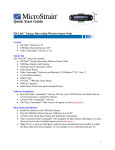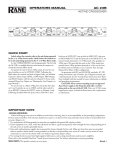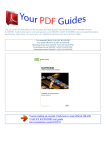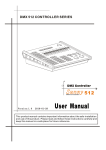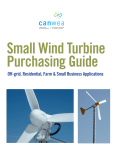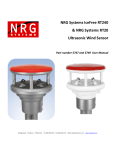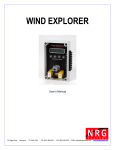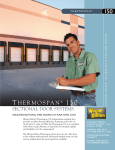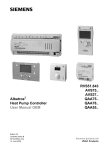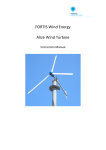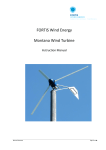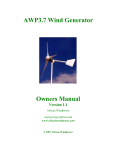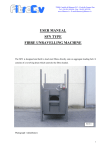Download User`s Manual - KSU-NREL
Transcript
User’s Manual 94 Harvest Lane · Williston · VT 05495 USA · TEL (802) 872-9600 · FAX (802) 264-9813 · EMAIL [email protected] · www.earthturbines.com © Earth Turbines, Inc. 94 Harvest Lane Williston, VT 05495 Tel: 802-872-9600 Fax: 802-264-9813 e-mail: [email protected] Specifications are subject to change without notice. \\et01\et\document tree\marketing\artwork\manuals\etwindwatcher_manual15.docx18 September 2007 Table of Contents Table of Contents Customer Support ................................................................................................................................................................... 4 Introduction.............................................................................................................................................................................. 5 Welcome! ............................................................................................................................................................................. 5 Using This Manual ............................................................................................................................................................... 5 Definitions ............................................................................................................................................................................ 5 Theory of Operation............................................................................................................................................................. 5 Features............................................................................................................................................................................... 5 Precautions ............................................................................................................................................................................. 6 Safety & Grounding ............................................................................................................................................................. 6 Environmental Considerations ............................................................................................................................................ 6 Unpacking the WindWatcher System .................................................................................................................................. 6 WindWatcher Components Map ............................................................................................................................................. 8 Sensor Installation ................................................................................................................................................................... 9 Connecting Sensors to the WindWatcher ............................................................................................................................. 10 Programming the WindWatcher ............................................................................................................................................ 12 Home ................................................................................................................................................................................. 12 Help ................................................................................................................................................................................... 12 Setup Menu ....................................................................................................................................................................... 12 Data Menu ......................................................................................................................................................................... 13 Wind Power Density Speed .................................................................................................................................................. 14 Technical Specifications........................................................................................................................................................ 15 Glossary ................................................................................................................................................................................ 17 Two Year Limited Warranty................................................................................................................................................... 18 Sending Repair Items to Earth Turbines ............................................................................................................................... 19 3 Customer Support Customer Support Earth Turbines offers support to help you get the most from your Earth Turbines product. If you have questions about your WindWatcher, first look in the printed product documentation. During our regular business hours, you may contact Earth Turbines for assistance using the information below. Customer Support is available 8:30 AM to 5:00 PM EST, Monday through Friday. Earth Turbines, Inc. 94 Harvest Lane Williston, Vermont 05495 U.S.A. Telephone: 802-872-9600 FAX: 802-264-9813 Email: [email protected] When you call or email, you should have the appropriate product documentation at hand and be prepared to give the following information: • • • • • • • • • Customer name Who purchased equipment Item number or description Serial number When equipment was purchased Where equipment is installed – climate and terrain conditions Description of the problem with some detail What events took place leading up to the problem What you have tried while attempting to solve the problem All instruments, sensors, software and towers manufactured by Earth Turbines are designed to be reliable and easy to use. We welcome your comments and appreciate your help in making Earth Turbines’ products the best available. 4 Introduction Introduction Welcome! Congratulations on your purchase of the Earth Turbines WindWatcher. The WindWatcher provides basic wind speed, direction, and wind power density information in an easy-to-install, easy-to-use package. Instantaneous and historical wind data are available at the touch of a button. Stored data can be used for prediction or verification of wind turbine performance. Inexpensive totalizers or weather stations that provide only average wind speed don’t give a complete picture of your site’s wind energy potential. The WindWatcher provides a professional quality, complete assessment. Using This Manual This User’s Manual should be read completely before installing and operating the WindWatcher. Be sure to review the Glossary so that you are familiar with important terminology. Follow all instructions and recommendations closely. Do not jeopardize the reliability of your data collection system by not being prepared with the required information and tools. Definitions This type style is used for the general body of this manual and is used for general descriptions and instructions to the user. This type style is used to warn users of a potential danger, either to themselves or to the equipment or data. Instructions in [Brackets] refer to WindWatcher’s navigation buttons and require you to press a button or series of buttons to perform a specific function. For example, pressing the [← Home] button will return the display to the “Home, Setup, Help, Data” menu. This type style is used to show actual prompts and messages that appear on the WindWatcher’s display. Theory of Operation The WindWatcher is an ultra-low power, microprocessor controlled wind measurement instrument. The WindWatcher constantly collects and records wind speed data and power in the wind. Once the wind speed and power data are collected, the WindWatcher then calculates the average wind speed, average power density, and wind power density speed. The wind power density speed can be used with your wind turbine specifications to get an accurate prediction or verification of your wind turbine’s performance. More detailed information regarding the WindWatcher’s calculation of wind power density speed can be found in the ‘Wind Power Density Speed’ section of this manual. The WindWatcher calculates monthly averages, wind power density, and provides a continuous log of the wind pattern. Averages and maximum values are calculated from continuous 2 second data samples. Samples are continuously averaged and are written into the WindWatcher’s history at the end of each month. Features • • • • • • • Simple to use Intuitive navigation Gives a complete picture of the wind pattern at your site Inexpensive turbine performance verification Operates on a single D-cell battery for one year Allows historical comparisons of 1 year’s worth of data Calculates actual power in the wind 5 Precautions Precautions Safety & Grounding The WindWatcher is intended to be mounted indoors. Please exercise caution when grounding your WindWatcher. Be sure to shut off the electricity to nearby light switches and electrical outlets before connecting the WindWatcher’s ground wire to an existing ground terminal. Environmental Considerations • • • • • • Your WindWatcher must be properly grounded. A ground wire is included and should be connected from the WindWatcher’s ground terminal to the ground of a nearby electrical outlet, cold water pipe, or other appropriate earth ground. It may be most convenient to locate the WindWatcher above an existing light switch or wall socket. Please consult an electrician if unsure about proper grounding. Sensor cables become less flexible and are more easily damaged at very low temperatures. Make sure that all sensor cables are securely fastened to the tower or mounting hardware so they do not move about in the wind. Be sure that all connections are tight and securely fastened to ensure reliability in high winds. Always use good quality alkaline batteries, and always stay within reasonable limits when establishing your battery replacement schedule. If mounting sensors to a tower, make sure that all sensor cables are spiral wrapped (2 wraps every 3 meters) around the tower to discourage natural frequency vibrations. Use a high quality electrical tape rated for extreme conditions to further secure the cables to the tower or mounting hardware. 3M Scotch® Super 88 electrical tape works very well in cold climates. Unpacking the WindWatcher System Confirm that you have received all components by comparing your order to the items below. Immediately contact Earth Turbines if any of the components are missing at 802-264-1906. The standard WindWatcher package includes: • • • • • • • • • WindWatcher wall plate with surface mounting box NRG #40 anemometer with black sensor terminal boot stub mast 30 m (100 feet) 2-conductor sensor cable screwdriver 4 screws User’s Manual (paper manual or on CD) ground wire D-cell battery 6 Precautions FACEPLATE SURFACE MOUNTING BOX ANEMOMETER SCREWS 2-CONDUCTOR SENSOR CABLE SCREWDRIVER GROUND WIRE STUB MAST BATTERY A wind direction vane, sensor cable, and mounting bracket are available for purchase separately. 7 BOOT Instrument Components Map WindWatcher Components Map FACEPLATE NAVIGATION BUTTONS NAVIGATION BUTTONS DISPLAY Figure 1 Figure 2 Display The liquid crystal display is activated by pressing any button on the instrument’s faceplate. As a power saving function, the display will always shut off after 5 minutes of no user activity. Navigation buttons Buttons correspond to the text instructions shown on the display. Press the corresponding button to choose a menu item, and then use the bottom right button to scroll through each menu item’s data screens. D-cell battery An alkaline D-cell battery is included with your WindWatcher. This battery will run the instrument for about 1 year before requiring replacement. The WindWatcher’s battery status screen will indicate when it is time to replace the battery. The WindWatcher will maintain all historical data and the current month’s data. Ground terminal The ground terminal is designed for connection directly to the earth ground of your home’s electrical system with the provided ground wire. The WindWatcher must be grounded before connecting any sensors. Failure to ground the WindWatcher voids its warranty and could result in damage to the unit. Channel description #40 The #40 channel has a built-in interface for the NRG #40 anemometer or NRG IceFreeII heated anemometer. It is very important that the WindWatcher is set up for the correct sensor because the output signals from the #40 anemometer and IceFreeII heated anemometer must be scaled differently. The WindWatcher will scale the wind speed data according to which sensor you’ve chosen in the [← Setup] menu. Vane The Vane channel has a built-in interface for the NRG 200P wind direction vane. 8 Installation Sensor Installation 1. Refer to Figures 3 and 4. • Insert the tinned ends of the sensor cable through the top of the rubber sensor terminal boot’s cable sleeve. • Pull through until the end of the cable with lugs extends out the top of the boot. • Slide the rubber sensor terminal boot and sensor onto the straight stub mast. • Secure the anemometer or wind direction vane with the supplied cotter pin and set screw. • Loosen the nuts on the studs on the sensor‘s base and slide on the lugs as follows: Anemometer: Connect the black wire to the anemometer’s – terminal, and connect the white wire to the anemometer’s + terminal. Wind Direction Vane: Connect the black wire to the wind vane’s – terminal, the white wire to the wind vane’s center terminal (signal), and the red wire to the wind vane’s + terminal. • Tighten the nuts down using a ¼” nut driver. Do not over-tighten. 2. Lightly coat the terminals with petroleum jelly, and slide the rubber boot over the bottom of the sensor. Secure the bottom of the rubber boot with electrical tape, leaving a hole for drainage of moisture (Figure 5). Do not tape the top of the boot to the sensor because if the tape unravels, it can interfere with the sensor’s rotation. Figure 3 Figure 4 Figure 5 3. Attach the sensor stub mast to your chosen installation site, and run sensor cables to the WindWatcher’s location in your house. It may be most convenient to locate the WindWatcher above an existing light switch or wall socket. 9 Installation Connecting Sensors to the WindWatcher 1. First connect the green ground wire to an appropriate ground in your home electrical system such as an electrical ground used for a nearby outlet or light switch, or a copper cold water line. The WindWatcher must be grounded before connecting any sensors to the logger. If you are unsure how to do this safely, consult an electrician. As with any electrical wiring, be sure to shut off all power to the area of the house in which you are working. 2. Remove the WindWatcher from surface mounting box provided and mount the box at the desired location in your house, thread sensor cable ends and green ground wire through the hole in the mounting box. 3. Connect the green ground wire to the WindWatcher’s ‘GND’ terminal (see Figure 6). 4. To connect the anemometer: • First connect the anemometer’s bare shield wire to the WindWatcher’s earth ground terminal (marked ‘GND’). • Touch the two signal wires to the earth terminal to dissipate any static electricity that has built up in the sensor. • Cables for the anemometer have white and black wires. To connect the two wires from the anemometer to the WindWatcher: • Connect the black wire to the “ #40 – “ terminal on the WindWatcher. • Connect the white or clear wire to the “ #40 + “ terminal on the WindWatcher. C Figure 6 10 Installation 5. To connect the optional NRG 200P wind direction vane: • Connect the vane’s bare shield wire to the WindWatcher’s earth ground terminal (marked ‘GND’). • Touch the three signal wires to each other. Then touch first the black wire and then the other wires to the earth terminal to dissipate any static electricity that has built up in the sensor. • Cables for the wind vane have red, white and black wires. To connect the three wires from the wind direction vane to the WindWatcher: • Connect the black wire to the “ Vane – “ terminal on the WindWatcher. • Connect the clear, or white, wire to the “ Vane SIG “ terminal on the WindWatcher. • Connect the red wire to the “ Vane + “ terminal on the WindWatcher. 6. Install the D-cell battery according to polarity indicated on battery holder. Check that the display comes on. 7. Attach the WindWatcher and faceplate assembly to the mounting box using the four white screws provided. 8. Use the buttons as described in ‘Programming the WindWatcher’ to navigate menus and program the WindWatcher. 11 Programming the WindWatcher Programming the WindWatcher Home The ← Home button (upper left button) can be pressed at any time to return you to the ← Home, ← Setup, Help →, Data → menu. The ← Home button is similar in function to a computer’s ESC (escape) key and can be used to quickly return to the introductory screen without making any changes. Help The Help → button is context sensitive. Help information will be related to whatever screen is displayed when the [→ Help] button is pushed. For example, if you are in the Change Units? screen and press the [→ Help] button, instructions regarding how to change or maintain the current units setting will scroll across the screen. Setup Menu Set Clock? To set the clock, push the [← Setup] button, and then [← Yes]. The instrument will prompt you to set the year. Adjust the year by using the [← -] and [+ →] buttons until the correct year is displayed. When the displayed year is correct, choose [OK →]. The next screen will prompt you to set the month. Adjust the month by using the [← -] and [+ →] buttons until the correct month is displayed. When the displayed month is correct, choose [OK →]. The next screen will prompt you to set the day. Adjust the day by using the [← -] and [+ →] buttons until the correct day is displayed. When the displayed day is correct, choose [OK →]. The next screen will prompt you to set the hour. Adjust the hour by using the [← -] and [+ →] buttons until the correct hour is displayed. Note that the instrument’s clock uses a 24:00 format. For example, for 5:00 pm, you must choose 17:00. When the displayed hour is correct, choose [OK →]. The next screen will prompt you to set the minute. Adjust the minute setting using the [← -] and [+ →] buttons until the correct minute is displayed. When the displayed minute is correct, choose [OK →]. Reset All Data? If you wish to clear all historical data and all of the current month’s data from the instrument’s memory, push the [←Setup] button, and press the [No →] button until the Reset All Data? menu appears. Push the [←Yes] button, and the instrument will ask Are you sure? Pressing [← Yes] again will clear all history data and current data from the instrument’s memory. Press [No →] or [← Home] if you do not wish to erase all data. Sensor Type Select the type of sensor that is connected to the WindWatcher. It is very important that the WindWatcher is set up for the correct sensor because the output signals from the #40 anemometer and IceFreeII heated anemometer must be scaled differently. The WindWatcher will scale the wind speed data according to which sensor you’ve chosen in the [← Setup] menu. All data, historical and current, will be displayed scaled based on the currently selected sensor type. 12 Programming the WindWatcher Enable / Disable Vane? If you do not have a NRG 200P wind direction vane connected to the WindWatcher, it is recommended that you disable the vane channel so that it does not record or display non-existent direction data. If you connect a wind direction vane to the WindWatcher and wish to record and display wind direction data, the wind vane channel must be enabled. To enable or disable the wind vane channel, push the [← Setup] button, and then repeatedly press the [No →] button until Enable Vane? or Disable Vane? appears. If the wind vane channel setting is currently disabled, Enable Vane? will be displayed. If the wind vane channel setting is currently enabled, the display will read Disable Vane? Push the [← Yes] button to change from the current setting; push the [← No] button to leave the setting as you found it. Show / Hide Power Data? You can instruct the WindWatcher to hide or display power data. Push the [← Setup] button, and then repeatedly press the [No →] button until Show Power Data? or Hide Power Data? appears on the display. If the power data screens are currently hidden, the display will read Show Power Data? If the power data screens are currently not hidden, the display will read Hide Power Data? You may press the upper right [→ Help] button for instructions if you are unsure. Push the [← Yes] button to change from the current setting; push the [← No] button to leave the setting as you found it. Change Units? The Change Units? screen is used to select between displaying wind speed in Imperial (mph) or SI (m/s) units. To change the units, push the [←Setup] button, and then repeatedly press the [No →] button until Change Units? appears on the display. Push the [← Yes] button to change from the current setting; push the [← No] button to leave the setting as you found it. If you are unsure of the current setting, press the upper right [→ Help] button for instructions. Data Menu ← Hist Pressing the [← Hist] button will display wind data for previous months. The most recent available month will be displayed. The [→ Nxt] button is used to scroll through: • average speed; • maximum gust; • direction of maximum gust (if you have a wind vane connected); • wind power density; • wind power density speed; • average direction measurements (if you have a wind vane connected). Use the lower left button to move backward chronologically. Please note that the current month’s data are not available until next month. 13 Programming the WindWatcher → Current Pressing the [→ Current] button will allow you to scroll through: • • • • • • • • • • current speed; current direction (if you have a wind vane connected); maximum gust; direction of gust (if you have a wind vane connected); average speed; average direction (if you have a wind vane connected); average power density; power density speed; battery status; clock time and date settings by pushing the [Nxt →] button. An explanation of any of these parameters can be obtained by pressing the upper right [Help →] button. Pushing the lower left button will allow you to view the previous screen. Wind Power Density Speed Average wind speed values alone do not give an accurate prediction of wind turbine performance. The power available from the wind is related to the cube of the wind speed. Therefore, a site with a few windy days, followed by a few days with no wind, can actually have a HIGHER energy content than a site with steady wind and the same average. To get the complete picture, you must know the wind speed frequency distribution, which tells the percentage of time that the wind is blowing at each wind speed. In many places, this wind speed frequency distribution follows a pattern called a “Rayleigh distribution”. If you know that the wind follows a Rayleigh distribution, then by knowing only the average wind speed, you can deduce the entire wind speed frequency distribution (a Rayleigh distribution is a special case of a Weibull distribution with an “α” or “shape factor” = 2.0). When wind turbine manufacturers project power production for a given model of wind turbine based on the average wind speed, they assume that the wind follows the Rayleigh distribution. Therefore, if you are using a turbine manufacturer’s power curve information to predict power generation at your site but your site does not fit the Rayleigh distribution, the wind turbine power predictions may be too optimistic or too pessimistic. The WindWatcher calculates the actual power in the wind, as well as the average wind speed. Once the WindWatcher calculates what the total power in the wind has been, it can calculate the equivalent average wind speed to get this same power at a site with a Rayleigh distribution of wind speeds. This value, called the “wind power density speed”, can be used with wind turbine specifications to get an accurate prediction or verification of wind turbine performance. More on this subject can be found in Wind Power for Home & Business: Renewable Energy for the 1990s and Beyond by Paul Gipe (Real Goods Independent Living Book, 1999). 14 Technical Specifications Technical Specifications Description Instrument type 2 channel micropower wind energy monitor Applications small wind turbine performance monitoring; wind resource assessment Sensor compatibility counter channels NRG #40 anemometer; IceFreeII Electrically Heated Anemometer Sensor compatibility - analog NRG 200P direction vane channels Data Collection Resolution Counter channels Anemometer channel dedicated for NRG #40 anemometer or IceFreeII Electrically Heated Anemometer Analog channels Wind vane channel dedicated for NRG 200P direction vane Sampling interval 2 seconds Averaging interval accumulated monthly average Real time clock clock retained in non-volatile memory Storage medium internal non-volatile memory Maximum data storage 1 year Parameters recorded for each channel • • • • • Data delivery On-screen Displayed resolution • speeds: 0.1 m/s or 0.1 mph, user selectable • direction to 1 degree Analog measurement resolution approx 0.5 degree Counter average stored resolution 0.1 m/s (0.1 mph) Analog average stored resolution 1 degree Min / Max stored resolution 0.1 m/s (0.1 mph) User interface • Liquid Crystal Display (LCD) 2 x 20 characters • 4 navigation buttons • on-screen menus Configurable parameters • display units • sensor type (#40 or IceFree II) • clock Sensor wiring terminal block on back of unit Supply voltage 1.5 V Supply current 1 mA Batteries 1.5 V alkaline D-cell Mounting • Mounts with 4 screws into any US standard 2-gang electrical box • surface-mount enclosure included Tools required Screwdriver for sensor terminals and mounting screws (included) Configuration Connections Power requirements Installation monthly wind speed average monthly maximum wind speed monthly average power density monthly power density speed monthly wind direction average 15 Technical Specifications Environmental Physical Materials Other accessories 200P wind direction vane, sensor mounting booms Operating temperature range -40 °C to 65 °C (-40 °F to 149 °F); display readable -20 °C to 60 °C (-4 °F to 140 °F) Operating humidity range 0 to 100% RH non-condensing Lifespan 10 years + Weight 0.34 kg (0.75 pounds) Dimensions 11.9 cm x 11.9 cm (4.7 inches x 4.7 inches) Faceplate Injection molded white ABS Buttons Blue ABS Display • Liquid Crystal Display (LCD) 2 x 16 characters • display readable from -20 °C to 60 °C (-4 °F to 140 °F) Wiring panel zinc plated terminal screws Enclosure • 2-gang surface-mount electrical box, UL approved Meets or exceeds wind energy industry standards. 16 Glossary Glossary Anemometer A sensing device that is used to measure wind velocity. The WindWatcher collects data from an anemometer and wind direction vane. The NRG #40 anemometer is a 3-cup anemometer. average direction The average of wind directions sampled thus far for the current month or recorded for a previous month. average power density The average power density based on the wind speed samples thus far for the current month. average wind speed The average of wind speeds sampled thus far for the current month or recorded for a previous month. averaging interval The time period over which the WindWatcher collects data for averaging. The WindWatcher continually averages sampled data and writes the averages into the data history at the end of each month. current wind speed Wind speed sampled for the previous 2 second period. current wind direction Wind direction sampled for the previous 2 second period. direction of gust Wind direction sampled at the time of the maximum 2 second wind speed. maximum gust The maximum 2 second wind speed recorded for the current month. power density speed This is the average speed back calculated from the accumulated power density assuming a Rayleigh distribution. Because this average takes the wind’s frequency distribution into consideration, it is a more accurate predictor of potential power generation from a wind turbine. Rayleigh distribution An assumed wind speed frequency distribution function that is used to estimate the energy production performance of a wind turbine.** sampling interval The time period between samples of the input sensors. The WindWatcher samples data once every two seconds. At the end of the averaging interval, the WindWatcher calculates and stores an average of these samples. storage interval The period of time that data are gathered before being stored to non-volatile memory. The WindWatcher has a storage interval of 1 month. terminal block Place where sensor and grounding wires are connected to the WindWatcher. wind direction The compass direction, as compass points (NE, NNE, etc.) or degrees (0 to 360°) from which the wind is blowing. ** See Wind Power for Home & Business: Renewable Energy for the 1990s and Beyond by Paul Gipe (Real Goods Independent Living Book, 1999) for more information. 17 Warranty Two Year Limited Warranty Earth Turbines, Inc. warrants its products for a period of two years from date of original purchase solely for the benefit of the original consumer purchaser. If this Earth Turbines product is determined to be defective in materials or workmanship, Earth Turbines will, at Earth Turbines’ option, repair or replace this product without charge. This warranty does not cover damage due to improper installation or use, accident or misuse, lightning or damages due to any unauthorized service. This warranty also will not apply if any seal on any instrument or sensor is broken or the equipment was not adequately grounded. To return a defective product, call Earth Turbines at the telephone number listed below for a RMA return authorization number. You must also have available when you call the serial number of the item as well as date of purchase. No products will be accepted for warranty work without a RMA number. The product must be returned, postage prepaid, to Earth Turbines with a brief description of the problem, RMA number and a return address with phone number. The foregoing limited warranty is given in lieu of all other warranties, express or implied. Earth Turbines specifically disclaims all implied warranties including, but not limited to, any implied warranties of merchantability and fitness for a particular purpose. The above limited warranty expressly excludes, and Earth Turbines shall not be liable for, any incidental or consequential damages caused by or related to the use of, inability to use or malfunction of this product. Prompt disposition: Earth Turbines will make a good faith effort for prompt correction or other adjustment with respect to any product which proves to be defective within the warranty period. First, contact Earth Turbines or the representative from whom the product was purchased and ask for a RMA number. Earth Turbines will also make a good faith effort for prompt service after the warranty period of a product has expired. Please contact Earth Turbines with the nature of the problem and serial number to obtain a RMA number. Inspect your shipments for damage to packages or missing packages immediately upon receipt. Record any such exceptions on the freight receipt of the delivery agent. If any contents are damaged or missing, report this in writing to the freight carrier and send Earth Turbines a copy of the damage report. If you insured the shipment yourself, report any damages to your insurance carrier. Tel: 802-872-9600 Fax: 802-264-9813 18 email: [email protected] Repairs Sending Repair Items to Earth Turbines If you wish to return an item to Earth Turbines for repair or any other reason, please before shipping contact Earth Turbines’ Service Department by phone (802) 872-9600 or fax (802) 264-9813 to obtain a Return Material Authorization (RMA) Number. The RMA Number allows us to track and route your shipment or repair. Note the RMA Number on all boxes shipped to us and refer to it in your correspondence or phone calls to us. Please fill out a copy of this sheet and send it with your shipment to Earth Turbines. Date: _____________ Your Name: ________________________________ RMA No: ______________ Items being returned: _____________________________________ Serial Number: ________________ Reason for return: _____________________________________________________________________ Warranty: Yes No Not Sure Estimate for repair charges requested? Purchase Date / Invoice No: ______________ Yes No Repair not to exceed US$: _______________ Person to be contacted with estimate: ____________________________ Phone: ___________________ Person to issue Purchase Order for repair: _________________________ Phone: __________________ Billing Address: Shipping Address: Send your shipment FREIGHT PREPAID and INSURED against loss or damage in transit to: Earth Turbines, Inc. Attn: Receiving Dept., RMA No. R-________ 94 Harvest Lane Williston, VT 05495, USA SHIPMENTS SENT FREIGHT COLLECT WILL NOT BE ACCEPTED BY EARTH TURBINES. International Customers please state the following in your shipping documents: “THESE ITEMS ARE BEING RETURNED TO THEIR U.S. MANUFACTURER. COUNTRY OF MANUFACTURE AND ORIGIN IS U.S.A. HS CODE 9801.00.1025 19



















